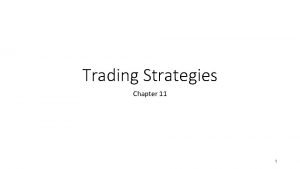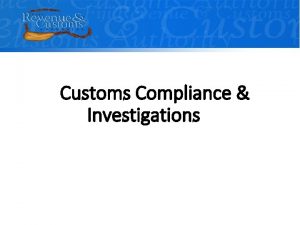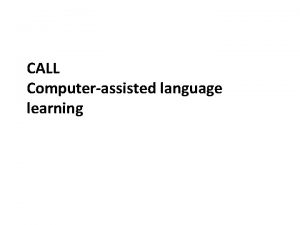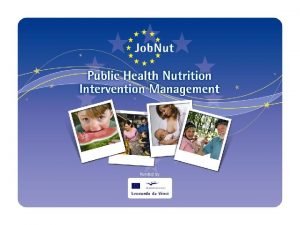A Call To Action for Compliance of the























![[Header] • [Text] [Header] • [Text]](https://slidetodoc.com/presentation_image_h/b806fb426b42c55863d481a4fca7a510/image-24.jpg)
![[Header] • [Text] [Header] • [Text]](https://slidetodoc.com/presentation_image_h/b806fb426b42c55863d481a4fca7a510/image-25.jpg)
- Slides: 25

A Call To Action for Compliance of the International Code of Marketing of Breast-milk Substitutes June 22, 2020

What is the Call to Action?

The Call to Action calls on the baby food sector to achieve full compliance with the International Code of Marketing of Breast-milk Substitutes and all its relevant, subsequent resolutions (collectively referred to as “the Code”) by 2030. It calls for breast-milk substitute (BMS) companies to: • Publicly acknowledge the Code; • Publicly commit to reach full Code compliance by 2030 at the latest; and • Submit a clear implementation roadmap by the end of 2020 detailing how Code compliance will be achieved. Accomplishing these on-the-record acknowledgements, commitments, and roadmaps would mark a historic step.

Why do we need this Call to Action?

The Need • The health, nutrition, and well-being of mothers and infants worldwide is a global concern and public health imperative – of which breastfeeding support, promotion, and optimal practices is vital. • Improved breastfeeding practices are one of the six World Health Assembly 2025 global targets for nutrition (target 50% exclusive breastfeeding globally). • Current rates of exclusive breastfeeding in first six months globally are only 42%. • More than 800, 000 children and 100, 000 women die each year due to suboptimal breastfeeding. • Breastfeeding is a human right. • Optimal practices help ensure a child survives and thrives in life. • It reduces the risk of mortality, serves as a child’s first immunization, reduces diarrheal and respiratory infections, among other benefits. • Women have the right to accurate, unbiased information to inform decisions on whether to breastfeed.

The Need (cont) • There are several critical barriers to improving breastfeeding rates: • • • Community and cultural norms; Limited health worker capacity and/or breastfeeding support; Lack of maternity protection and work; Perception of insufficient milk (real or perceived); Lack of awareness of breastfeeding benefits; and Marketing of formula. • Formula marketing impacts breastfeeding practices, influencing: • • • Social norms of formula use; Attitudes about the safety and benefits of formula (suggesting ingredients improve intelligence and will address hunger, sleep, and digestive problems); Maternal confidence, leading mothers to question if they have enough milk; and Health system practices (e. g. free provision of formula to new mothers). • In many settings, formula is regularly marketed directly to consumers via mass media, print advertisements, and increasingly on social media, and through promotions to and through health workers, health facilities, and retailers. • Cross-branding also leads to promotion of entire product lines and consumer confusion. • The strongest evidence of negative impact is found when formula is provided for free in maternity facilities and when they are promoted by health workers.

The Need (cont) • In service of ending the practice of formula marketing, the Code was established and endorsed by the World Health Assembly in 1981. • It acts as normative guidance for companies and countries and is considered to be the international standard. • Its goal is to protect infant health and development by ensuring that the distribution and sale of BMS do not undermine breastfeeding, so parents are able to decide how to feed their children free of commercial influence, specifically by seeking to prohibit all advertising and other forms of promotion of BMS through media, retail channels, and health care facilities. • While efforts to curb marketing practices that violate the Code have seen results, all companies can and must go further to ensure full compliance in all geographies. • The 2018 Access to Nutrition Initiative’s (ATNI’s) Global Index showed, the leading company was only 46% compliant with the Code. • The controversy over BMS marketing is holding back private sector from making a more positive contribution to global nutrition challenges. • Formula companies are prohibited from joining many global initiatives and partnerships. • Issue contributes to general distrust of private sector among global nutrition stakeholders. • To further progress, the Call to Action takes an approach to directly appeal to companies to take action, supplementing advocacy, social behavior change, and consumer education.

In order to help ensure that all infants and young children worldwide are optimally breastfed and eat a healthy diet, seven civil society organizations and United Nations (UN) agencies are calling on all manufacturers of BMS to be compliant with the Code.

1 The Call to Action calls on BMS companies to: Publicly commit to full compliance with the Code and subsequent resolutions globally (including coverage of BMS up to 36 months of age), and disclose a concrete plan for achieving this goal by 2030 at the latest, with delineation of clear incremental steps.

2 As a first step toward full Code compliance, by the end of 2020: A For companies that do not currently have a BMS marketing policy, adopt a Codealigned BMS marketing policy for all countries for products marketed as suitable for infants between birth and 12 months of age, and commit to upholding the policy in all jurisdictions where regulations are absent or less stringent than the policy. In countries where national law is more stringent than the company policy, adherence to national law always takes precedence. B For companies that have a BMS marketing policy in place, ensure that current company policy and practices (including promotion to consumers and healthcare providers) are Code-aligned and, for products marketed as suitable for infants between birth and 12 months of age, extend them to all countries, and commit to upholding the policy in all jurisdictions even where regulations are absent or less stringent than the policy. In countries where national law is more stringent than the company policy, adherence to national law always takes precedence.

3 Commit to full adherence to national law in countries where national law is more stringent than current company policy. 4 Commit to support the adoption and implementation of national legislation fully aligned with the Code in order to create a level playing field for all companies.

5 Agree to provide information on company policies and practices to ATNI as requested, recognizing ATNI as an independent actor responsible for monitoring companies’ progress toward plans for achieving Code compliance.

Signatories

The Call to Action and Code Advocacy

The Call to Action is only one tool in an ongoing, multi-prong effort to ensure full Code compliance globally.

Advancing toward Code Compliance • Legislation, consumer engagement, and voluntary company actions are all needed to further progress on the Code. • The Call to Action is just one tool, intended to further voluntary company actions. Legislatio n Company actions Consumer engagement • It is meant to complement – not replace – ongoing national and global efforts to enact and enforce legal measures to implement the Code and efforts to inform consumers. • It also reinforces the need for companies to adhere to national legislation and pushes them to adopt policies that are fully Codealigned (if existing legislation is less stringent than the Code).

Why the 10 -Year Window • The signatories call on companies to achieve Code compliance as soon as possible, with the Call to Action giving them until 2030 • The timeline aligns with the timeframe of the Sustainable Development Goals (SDGs) and allows time for companies to make the necessary adjustments in business models and meet training and monitoring needs. • Proposing a shorter timeframe that does not factor in the complexity of internal business systems poses a greater risk that companies will walk away from the Call to Action and not take any steps at all toward full Code compliance. • There actions that the Call to Action asks companies to complete by 2020 to ensure meaningful steps are taken well before 2030: • • • Public commitment to the Code, Marketing policy that applies to products targeting infants 0 -12 months of age in all countries – no BMS company currently has this in place and will require all companies to go beyond their current policies and practices, and Present an implementation roadmap to achieve Code compliance by 2030. • In calling on companies to set their own plans the Call to Action acknowledges that companies are at different points in becoming Code compliant and vary in terms of geographic focus, revenue derived from BMS, and other factors.

Accountability and Monitoring • The public-facing nature of the Call to Action will make companies accountable to their implementation roadmaps. • Signatories of the Call to Action will assess initial responses from companies, requested by September 2020. • ATNI will conduct independent monitoring of the implementation roadmaps, through 2030. • ATNI will monitor and publish evaluations of company policies and practices. • The 10 largest companies will continue to be assessed in terms of Code compliance in forthcoming Global Access to Nutrition Indexes.

Who Has Received the Call to Action?

Companies Contacted • 20 of the largest BMS companies were contacted directly and asked to respond. • Industry associations also received the Call to Action – reaching additional companies. • Advocates can consider sending the Call to Action directly to additional companies, inviting them to respond.

The Call to Action applies to ALL BMS Companies.

Questions

Thank You
![Header Text [Header] • [Text]](https://slidetodoc.com/presentation_image_h/b806fb426b42c55863d481a4fca7a510/image-24.jpg)
[Header] • [Text]
![Header Text [Header] • [Text]](https://slidetodoc.com/presentation_image_h/b806fb426b42c55863d481a4fca7a510/image-25.jpg)
[Header] • [Text]
 Long call short call
Long call short call Stock options terminology
Stock options terminology +call +recording +call +centers +gartner
+call +recording +call +centers +gartner Call to action conclusion
Call to action conclusion Call to action bms
Call to action bms What is a conclusion in a persuasive essay
What is a conclusion in a persuasive essay Final thoughts examples
Final thoughts examples Problem solution essay introduction
Problem solution essay introduction Free call to action templates
Free call to action templates Indikation för kejsarsnitt på moderns önskan
Indikation för kejsarsnitt på moderns önskan Datorkunskap för nybörjare
Datorkunskap för nybörjare Plagg i rom
Plagg i rom Steg för steg rita
Steg för steg rita Ministerstyre för och nackdelar
Ministerstyre för och nackdelar Tack för att ni lyssnade bild
Tack för att ni lyssnade bild Claes martinsson
Claes martinsson Sju principer för tillitsbaserad styrning
Sju principer för tillitsbaserad styrning Dikt med fri form
Dikt med fri form Nyckelkompetenser för livslångt lärande
Nyckelkompetenser för livslångt lärande Modell för handledningsprocess
Modell för handledningsprocess Vilotidsbok
Vilotidsbok Orubbliga rättigheter
Orubbliga rättigheter Borstål, egenskaper
Borstål, egenskaper Bamse för de yngsta
Bamse för de yngsta Verktyg för automatisering av utbetalningar
Verktyg för automatisering av utbetalningar Exspektans eller expektans
Exspektans eller expektans
















































